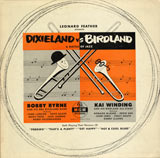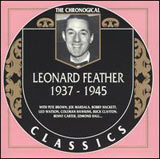Musician and Composer
Leonard Feather was a talented musician though rarely recorded, in part because of the Musician's Union regulations prohibiting the recording of non-members. Feather was a prolific composer and lyricist. He recorded over 100 songs and wrote the album notes for thousands of LPs, in addition to being an active arranger and producer. By his own estimation, his first quality composition was 'Mighty Like the Blues' performed by Benny Carter, Coleman Hawkins, and George Chisholm in 1937.
The list of names associated with Leonard Feather's work is both long and distinguished: Lionel Hampton, Duke Ellington, Benny Goodman, Fats Waller, Count Basie, Charlie Barnet, Charlie Parker, Sarah Vaughan, Dinah Washington, Billie Holiday, George Shearing, and many others. Some of Feather's best-known songs include "Evil Gal Blues," "Blow Top Blues," "Dinah's Blues," "I Remember Bird," and "Twelve Tone Blues." Arguably his greatest hit was "How Blue Can You Get," first performed by Lois Jordan and B.B. King. Leonard Feather also penned many lesser-known songs such as "Get Rich Quick" and "Taxi Blues." On October 16, 1951, these songs were the first ever recorded by a teenager named Richard Penniman, later known as Little Richard.
Partial discography
- 1937-1945: Leonard Feather 1937-1945 (Classics)
- 1951: Leonard Feather’s Swingin’ Swedes (Prestige)
- 1954: Dixieland vs. Birdland (MGM)
- 1954: Cats Vs. Chicks (MGM)
- 1954: Winter Sequence (MGM)
- 1956: West Coast vs. East Coast (MGM)
- 1956: Swingin’ on the Vibories (MGM)
- 1957: Hi-Fi Suite (MGM)
- 1957: 52nd Street (VSOP)
- 1958: Swingin’ Seasons (MGM)
- 1959: Jazz from Two Sides (Concept)
- 1971: Night Blooming Jazzmen (Mainstream)
- 1971: Freedom Jazz Dance (Mainstream)
- 1971-1972: Night Blooming (Mainstream)
- 1972: All-Stars (Mainstream)
- 1997: Presents Bop (Tofrec)
From The Encyclopedia of Popular Music pp.414


